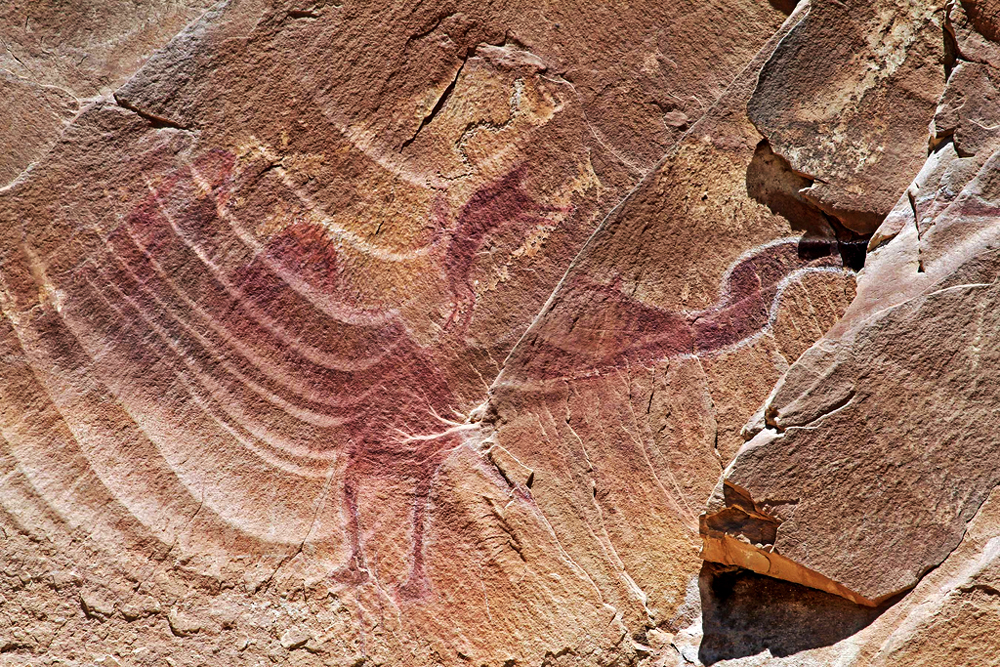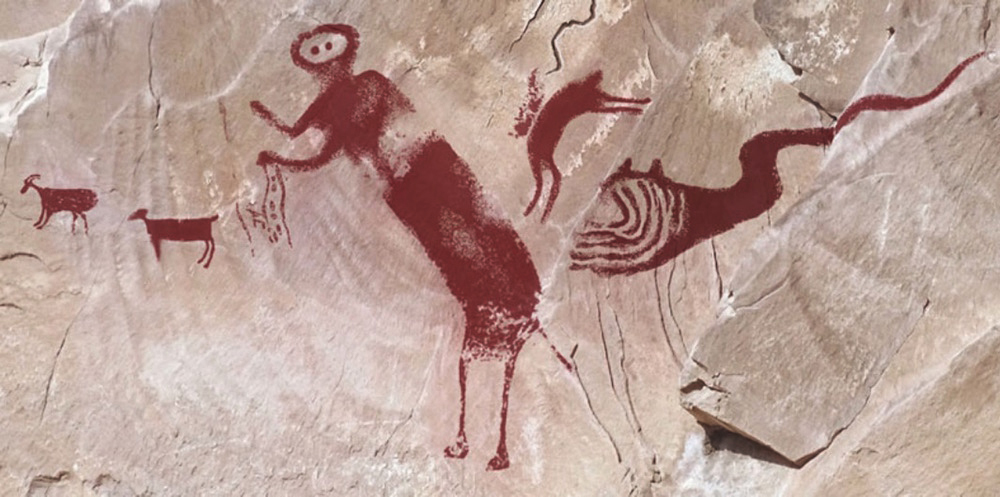


An article by Laura Geggel on LiveScience - Winged Monster' Rock Art Finally Deciphered - reports on the mystery surrounding the ancient rock paintings of Utah's Black Dragon Canyon.

For decades, researchers and creationists have debated whether the vibrant red pictographs are images of humans and animals, or rather, depictions of a large winged monster, possibly a pterosaur.
Now, using cutting-edge technology, researchers suggest the red paintings show five separate images, including a tall figure, a small figure, a sheep, a dog and a serpent-like figure.
"It is not a single figure. It is not a pterodactyl," said co-lead researcher Paul Bahn, a freelance archaeologist. "It's a beautiful set of images."
The rock paintings belong to the agrarian Fremont culture (circa A.D. 1 to 1100). Other Fremont rock paintings - known as Barrier Canyon style - show abstract humanlike figures with elongated bodies and round heads. These long figures are usually accompanied by tiny "attendants," including people, birds and four-legged creatures, such as hoofed animals, canines, felines, badgers and bears.
Amateurs discovered the painting in 1928, and soon after talk of the "winged monster" - a pterosaur, a Cretaceous flying reptile - arose.
But for researchers today, the painted area clearly shows separate images, not a single image of a pterosaur.
Benjamin Smith, a professor of world rock art at the University of Western Australia, stressed that humans knew little about dinosaurs and other extinct animals until the 1800's, long after the Fremont culture people painted Black Dragon Canyon.
"Since Native American art is of spiritual significance and holds significant religious content, images can also depict magical and mythical subject matter," said Smith, who was not involved with the study. "Not all animals in Native American art therefore need to depict real-world creatures. Some will be supernatural, but none will be dinosaurs."

Bahn and his colleague Jean-Loic Le Quellec, a rock-art expert at the French National Centre for Scientific Research, have used new techniques, including a tool called DStretch and a portable X-ray fluorescence device. These highlight the original pigments in the painting, in this case ochre, even when the colors aren't visible to the naked eye. Users can also disentangle colors from unwanted additions, such as chalk. Bahn states that Dstretch reveals that these are a set of separate figures. What was supposed to be one wing of this pterodactyl is actually two little four-legged animals. The so-called head and beak and neck of the pterodactyl are actually a human figure with its spindly legs and its two arms stretching out.
The study was published in the August issue of the journal Antiquity:
'The death of a pterodactyl'
Jean-Loic Le Quellec, Paul Bahn and Marvin Rowe
Antiquity / Volume 89 / Issue 346 / August 2015, pp 872-884
Abstract
The pictograph discovered at Black Dragon Canyon, Utah, in the late 1920's, is a classic example of the Barrier Canyon style, dating probably to AD 1-1100. Creationists, however, have argued, from the incomplete preservation of the motifs, that it depicts a winged monster or pterosaur. A new study using portable X-ray fluorescence refutes this ill-founded interpretation and reveals a scene characteristic of Barrier Canyon style, featuring an anthropomorphic figure. By removing interpretational bias, the new technology finally lays to rest the Black Dragon Canyon pterosaur.
Visit the American Rock Art Archive:
http://www.bradshawfoundation.com/america/index.php
by Bradshaw Foundation
Monday 30 May 2022
by Bradshaw Foundation
Wednesday 19 January 2022
by Bradshaw Foundation
Thursday 06 January 2022
by Bradshaw Foundation
Monday 06 December 2021
by Bradshaw Foundation
Monday 29 November 2021
by Bradshaw Foundation
Monday 25 October 2021
by Bradshaw Foundation
Monday 12 July 2021
by Bradshaw Foundation
Monday 24 May 2021
by Bradshaw Foundation
Tuesday 20 April 2021
by Bradshaw Foundation
Thursday 01 April 2021
by Bradshaw Foundation
Tuesday 23 February 2021
by Bradshaw Foundation
Thursday 14 January 2021
by Bradshaw Foundation
Friday 18 December 2020
by Bradshaw Foundation
Sunday 06 December 2020
by Bradshaw Foundation
Thursday 26 November 2020
by Bradshaw Foundation
Wednesday 07 October 2020
by Bradshaw Foundation
Monday 30 May 2022
by Bradshaw Foundation
Wednesday 19 January 2022
by Bradshaw Foundation
Thursday 06 January 2022
by Bradshaw Foundation
Monday 06 December 2021
by Bradshaw Foundation
Monday 29 November 2021
by Bradshaw Foundation
Monday 25 October 2021
by Bradshaw Foundation
Monday 12 July 2021
by Bradshaw Foundation
Monday 24 May 2021
by Bradshaw Foundation
Tuesday 20 April 2021
by Bradshaw Foundation
Thursday 01 April 2021
by Bradshaw Foundation
Tuesday 23 February 2021
by Bradshaw Foundation
Thursday 14 January 2021
by Bradshaw Foundation
Friday 18 December 2020
by Bradshaw Foundation
Sunday 06 December 2020
by Bradshaw Foundation
Thursday 26 November 2020
by Bradshaw Foundation
Wednesday 07 October 2020
Friend of the Foundation











